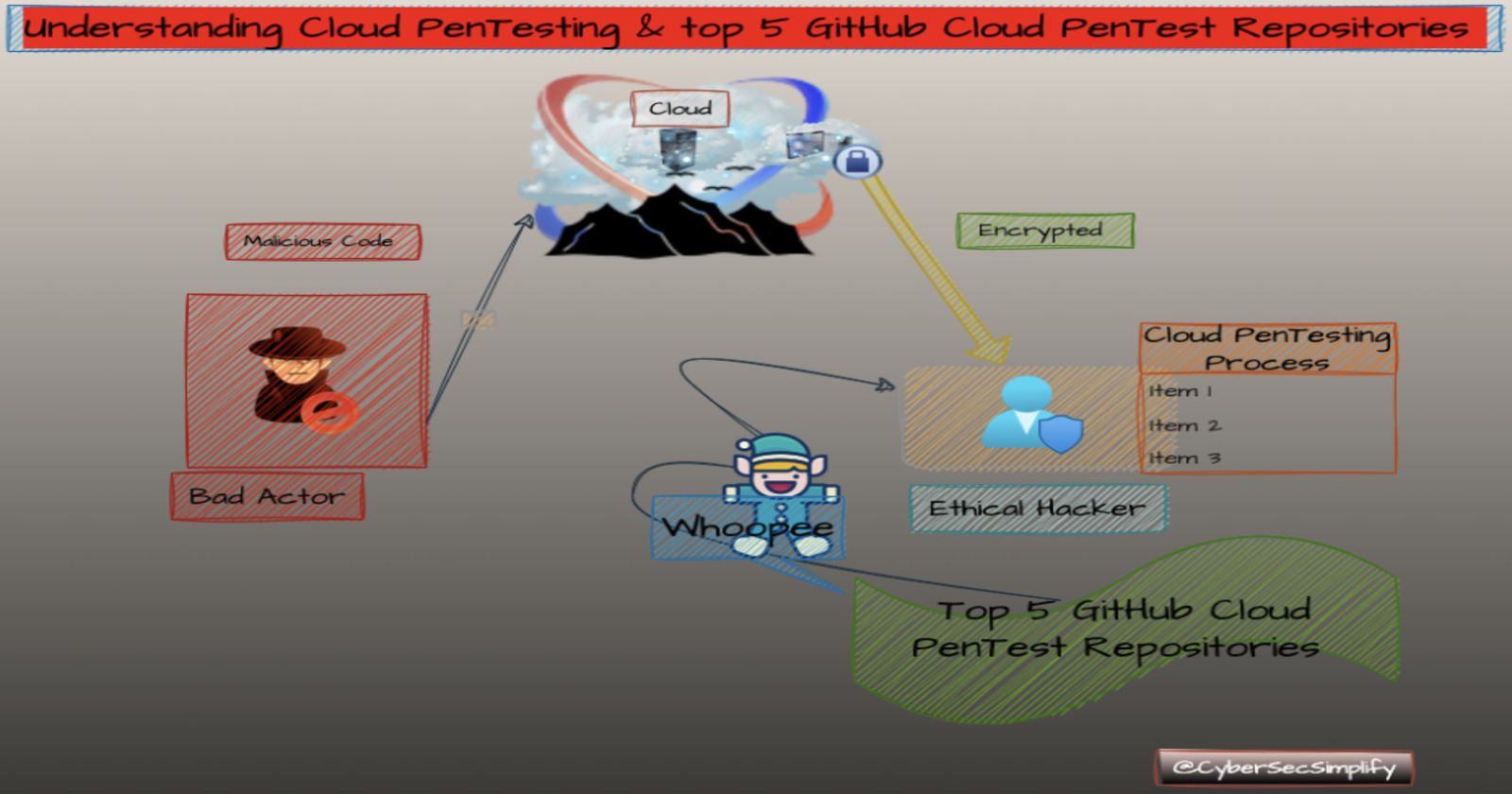Understanding Cloud PenTesting: Why it's Important & The Top 5 -GitHub Repositories to Get You Started
 Abhiney Sharma
Abhiney SharmaTable of contents
- Introduction:-
- What is Cloud Pentesting?
- Why is Cloud Pentesting Important?
- Best Practices for Cloud Pentesting:-
- The following is a general outline of the Cloud Pentesting process:-
- Top 5 GitHub Repositories for cloud penetration testing
- Conclusion:-
- Acknowledgement to the creators and maintainers of Awesome cloud GitHub repositories

Here is another interesting article by CyberSecSimplify for all cloud security enthusiasts, particularly those interested in cloud pentesting.
This article delves into the latest developments and trends in the field of cloud security, with a specific focus on cloud pentesting, providing valuable insights and information to help readers understand the importance of cloud pentesting and how to perform it effectively.
The article also includes a list of the top 5 GitHub repositories for cloud pentesting resources, which will provide the readers with a wealth of information and tools for cloud security testing and automation.
Whether you are a seasoned professional or a curious beginner, this article is sure to provide valuable information and inspiration for anyone interested in the exciting world of cloud security and cloud pentesting.
Introduction:-
A cloud penetration test, or pentest, is a simulated cyber attack on a cloud environment to identify vulnerabilities and assess the overall security of the system.
In this article, we will explore the basics of cloud pentesting, including best practices, tools, and resources, the general outline of the process as well as the top five GitHub repositories for cloud pentesting resources.
What is Cloud Pentesting?
Cloud pentesting is a method of evaluating the security of cloud-based systems, applications, and infrastructure. The goal of a cloud pentest is to identify and safely exploit any vulnerabilities present in the system, allowing organisations to remediate any issues before they can be exploited by malicious actors.
Why is Cloud Pentesting Important?
One of the key benefits of cloud pentesting is that it allows organisations to test their systems and applications in a realistic environment that mimics the conditions of a live production system. This allows security teams to identify and address vulnerabilities that may not be discovered through traditional testing methods, such as manual code reviews or automated vulnerability scanning.
Additionally, cloud pentesting can help organisations to comply with industry regulations and standards, such as the Payment Card Industry Data Security Standard (PCI DSS).
Best Practices for Cloud Pentesting:-
Understand the scope and objectives of the pentest, including the specific cloud environment and assets to be tested.Use a combination of automated and manual testing methods to identify vulnerabilities.Prioritise testing of high-risk areas and sensitive data.Use multi-factor authentication for all access to the cloud environment.Regularly update and patch all systems and software.Implement and maintain a strong network segmentation strategy.Continuously monitor and review log files for unusual activity.Conduct regular penetration testing and vulnerability assessments.Have an incident response plan in place.Familiarise yourself with cloud-specific security challenges, such as shared responsibility models and lack of physical controls.Make sure to respect any compliance and regulatory requirements that apply to the specific cloud environment.Coordinate with client's security and compliance teams to ensure that testing aligns with their policies and procedures.
The following is a general outline of the Cloud Pentesting process:-
Planning and preparation: Define the scope and objectives of the pentest, including the specific cloud environment and assets to be tested. Coordinate with the client's security and compliance teams to ensure that testing aligns with their policies and procedures.
Information gathering: Gather information about the cloud environment, such as IP addresses, network topology, and system configurations, using tools such as port scanners, vulnerability scanners, and reconnaissance techniques.
Vulnerability assessment: Identify vulnerabilities in the cloud environment using automated and manual testing methods. This may include testing for common vulnerabilities such as weak passwords, misconfigured servers, and missing patches.
Exploitation: Attempt to exploit any identified vulnerabilities to gain unauthorised access to the cloud environment.
Post-exploitation: Attempt to move laterally within the cloud environment and identify any sensitive data or privileged access.
Reporting: Prepare a comprehensive report detailing the findings of the pentest, including any identified vulnerabilities and recommended remediation steps.
Remediation: Work with the client to address any identified vulnerabilities and improve the overall security of the cloud environment.
It's important to keep in mind that Cloud PenTesting requires some extra care and attention due to its dynamic nature of environments. And one should always respect any compliance and regulatory requirements that apply to the specific cloud environment.
Here are some recommended books on the listed Cloud Pentesting:
Pentesting Azure Applications: The Definitive Guide to Testing and Securing Deployments
Hands-On AWS Penetration Testing with Kali Linux
Penetration Testing Azure for Ethical hackers
Now, let's dive into the heart of the matter and take a look at the top 5 GitHub repositories for cloud penetration testing.
Top 5 GitHub Repositories for cloud penetration testing
Conclusion:-
Cloud pen-testing is an essential aspect of cloud security that allows organisations to identify and address vulnerabilities in their systems and applications. By utilising advanced tools and techniques, and by following industry standards and best practices, organisations can improve their overall security posture and reduce their risk of cyber attacks.
The above-mentioned GitHub repositories are some of the best resources for cloud pen-testing, providing a wealth of information and tools for cloud security testing and automation.
Finally, it is imperative to remember that utilising these resources must be done by the terms of service, and all relevant regulations and laws must be adhered to. Failure to do so can result in serious legal and financial consequences. It is of the utmost importance to ensure that all penetration testing activities are conducted responsibly, ethically, and in compliance with all applicable laws and regulations**.**
Acknowledgement to the creators and maintainers of Awesome cloud GitHub repositories
We would like to extend our sincere appreciation to the creators and maintainers of the outstanding cloud GitHub repositories that have been discussed in this article. Their contributions through the sharing of knowledge and tools have played a vital role in the field of cloud security. Their hard work and dedication is truly commendable.
We thank you for reading this article and hope it provided you with valuable information. We encourage you to follow and support our cybersecsimplify community for more informative and in-depth articles on cybersecurity.
Subscribe to my newsletter
Read articles from Abhiney Sharma directly inside your inbox. Subscribe to the newsletter, and don't miss out.
Written by

Abhiney Sharma
Abhiney Sharma
Educating myself and others, raising cybersecurity awareness about these topics, providing Industry Insights and developments, developing Career Opportunities, and creating and Contributing to a Community of like-minded professionals. Professional Bio : Cybersecurity Enthusiast || Infrastructure Delivery Manager || (ISC)² Certified in Cybersecurity -(CC) || CEH || NSD Empaneled ISAC Certified -CCIO(Cyber Crime Intervention Officer)|| CPEW || NSE2 || 🔸🔸 Achievements 🔸🔸 I am thrilled to share that I have been recognized as one of the top 15 Cyber Security Researchers in India by the Nation's Critical Information Infrastructure Protection Center (NCIIPC India) in the third quarter of 2022, out of 407 researchers. This achievement was featured in their October newsletter- 2022. 🔗🔗 https://nciipc.gov.in/documents/NCIIPC_Newsletter_Oct22.pdf 🔸 Got Appreciation Mail from the Dutch government to find bugs and secure their domains.